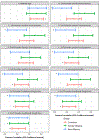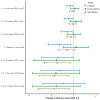Maternal cardiometabolic factors and genetic ancestry influence epigenetic aging of the placenta
- PMID: 31948495
- PMCID: PMC7365741
- DOI: 10.1017/S2040174419000801
Maternal cardiometabolic factors and genetic ancestry influence epigenetic aging of the placenta
Abstract
Disruption of physiological aging of the placenta can lead to pregnancy complications and increased risk for cardiometabolic diseases during childhood and adulthood. Maternal metabolic and genetic factors need to operate in concert with placental development for optimal pregnancy outcome. However, it is unknown whether maternal cardiometabolic status and genetic ancestry contribute to differences in placental epigenetic age acceleration (PAA). We investigated whether maternal prepregnancy obesity, gestational weight gain (GWG), blood pressure, and genetic ancestry influence PAA. Among 301 pregnant women from 4 race/ethnic groups who provided placenta samples at delivery as part of the National Institute of Child Health and Human Development Fetal Growth Studies, placental DNA methylation age was estimated using 62 CpGs known to predict placental aging. PAA was defined to be the difference between placental DNA methylation age and gestational age at birth. Percentage of genetic ancestries was estimated using genotype data. We found that a 1 kg/week increase in GWG was associated with up to 1.71 (95% CI: -3.11, -0.32) week lower PAA. Offspring Native American ancestry and African ancestry were associated, respectively, with higher and lower PAA among Hispanics, and maternal East Asian ancestry was associated with lower PAA among Asians (p < 0.05). Among mothers with a male offspring, blood pressure was associated with lower PAA across all three trimesters (p < 0.05), prepregnancy obesity compared to normal weight was associated with 1.24 (95% CI: -2.24, -0.25) week lower PAA. In summary, we observed that maternal cardiometabolic factors and genetic ancestry influence placental epigenetic aging and some of these influences may be male offspring-specific.
Keywords: Obesity; ancestry; blood pressure; epigenetic aging; gestational weight gain; placental aging.
Conflict of interest statement
Figures


References
-
- Chen K, Chen L, Lee Y. Exploring the relationship between preterm placental calcification and adverse maternal and fetal outcome. Ultrasound in Obstetrics & Gynecology. 2011;37(3), 328–334. - PubMed
-
- Chen K-H, Chen L-R, Lee Y-H. The role of preterm placental calcification in high-risk pregnancy as a predictor of poor uteroplacental blood flow and adverse pregnancy outcome. Ultrasound in medicine &biology. 2012;38(6), 1011–1018. - PubMed
-
- Biron-Shental T, Sukenik-Halevy R, Sharon Y, et al. Short telomeres may play a role in placental dysfunction in preeclampsia and intrauterine growth restriction. American journal of obstetrics and gynecology. 2010;202(4), 381. e381–381. e387. - PubMed
-
- Maiti K, Sultana Z, Aitken RJ, et al. Evidence that fetal death is associated with placental aging. American journal of obstetrics and gynecology. 2017;217(4), 441. e441–441. e414. - PubMed
-
- Sultana Z, Maiti K, Aitken J, Morris J, Dedman L, Smith R. Oxidative stress, placental ageing-related pathologies and adverse pregnancy outcomes. American Journal of Reproductive Immunology. 2017;77(5), e12653. - PubMed
Publication types
MeSH terms
Grants and funding
LinkOut - more resources
Full Text Sources

